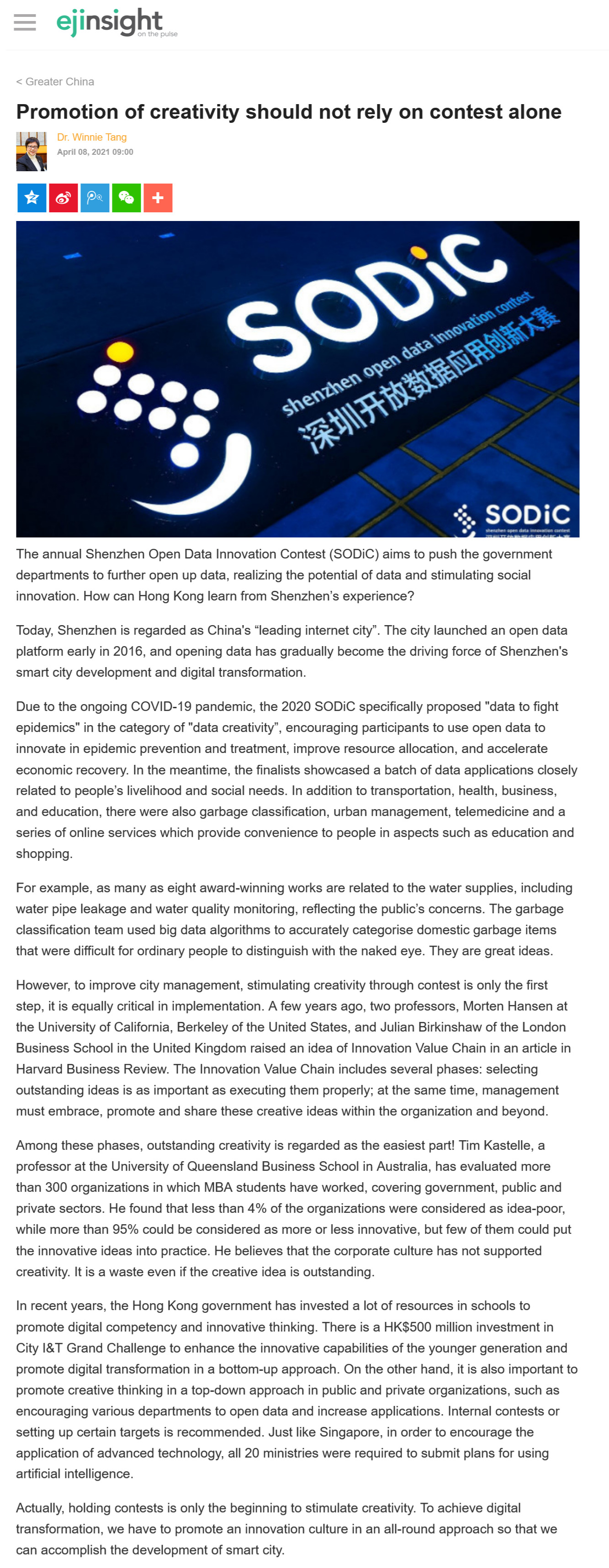網上版請按此

Promotion of creativity should not rely on contest alone
The annual Shenzhen Open Data Innovation Contest (SODiC) aims to push the government departments to further open up data, realizing the potential of data and stimulating social innovation. How can Hong Kong learn from Shenzhen’s experience?
Today, Shenzhen is regarded as China's “leading internet city”. The city launched an open data platform early in 2016, and opening data has gradually become the driving force of Shenzhen's smart city development and digital transformation.
Due to the ongoing COVID-19 pandemic, the 2020 SODiC specifically proposed "data to fight epidemics" in the category of "data creativity”, encouraging participants to use open data to innovate in epidemic prevention and treatment, improve resource allocation, and accelerate economic recovery. In the meantime, the finalists showcased a batch of data applications closely related to people’s livelihood and social needs. In addition to transportation, health, business, and education, there were also garbage classification, urban management, telemedicine and a series of online services which provide convenience to people in aspects such as education and shopping.
For example, as many as eight award-winning works are related to the water supplies, including water pipe leakage and water quality monitoring, reflecting the public’s concerns. The garbage classification team used big data algorithms to accurately categorise domestic garbage items that were difficult for ordinary people to distinguish with the naked eye. They are great ideas.
However, to improve city management, stimulating creativity through contest is only the first step, it is equally critical in implementation. A few years ago, two professors, Morten Hansen at the University of California, Berkeley of the United States, and Julian Birkinshaw of the London Business School in the United Kingdom raised an idea of Innovation Value Chain in an article in Harvard Business Review. The Innovation Value Chain includes several phases: selecting outstanding ideas is as important as executing them properly; at the same time, management must embrace, promote and share these creative ideas within the organization and beyond.
Among these phases, outstanding creativity is regarded as the easiest part! Tim Kastelle, a professor at the University of Queensland Business School in Australia, has evaluated more than 300 organizations in which MBA students have worked, covering government, public and private sectors. He found that less than 4% of the organizations were considered as idea-poor, while more than 95% could be considered as more or less innovative, but few of them could put the innovative ideas into practice. He believes that the corporate culture has not supported creativity. It is a waste even if the creative idea is outstanding.
In recent years, the Hong Kong government has invested a lot of resources in schools to promote digital competency and innovative thinking. There is a HK$500 million investment in City I&T Grand Challenge to enhance the innovative capabilities of the younger generation and promote digital transformation in a bottom-up approach. On the other hand, it is also important to promote creative thinking in a top-down approach in public and private organizations, such as encouraging various departments to open data and increase applications. Internal contests or setting up certain targets is recommended. Just like Singapore, in order to encourage the application of advanced technology, all 20 ministries were required to submit plans for using artificial intelligence.
Actually, holding contests is only the beginning to stimulate creativity. To achieve digital transformation, we have to promote an innovation culture in an all-round approach so that we can accomplish the development of smart city.
Dr. Winnie Tang
Adjunct Professor, Department of Computer Science, Faculty of Engineering; Department of Geography, Faculty of Social Sciences; and Faculty of Architecture, The University of Hong Kong